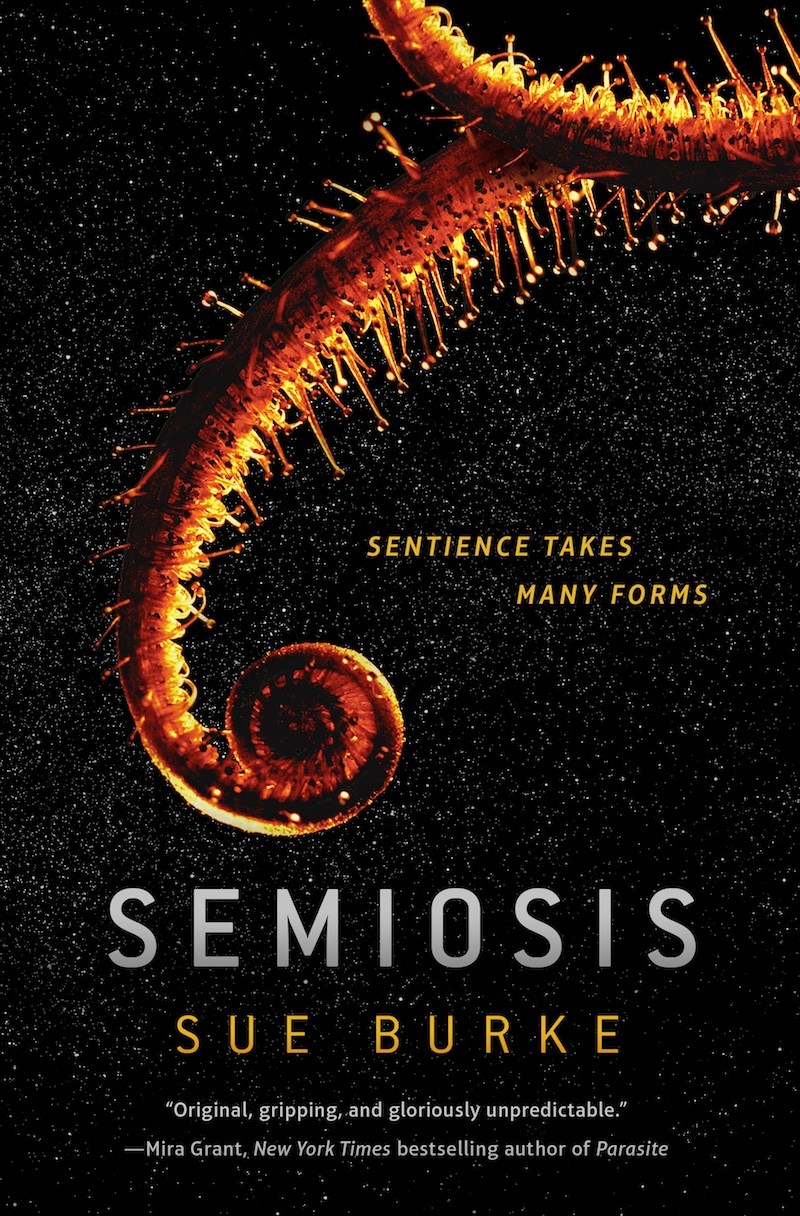 Sue Burke is joining us today with her novel Semiosis. Here’s the publisher’s description:
Sue Burke is joining us today with her novel Semiosis. Here’s the publisher’s description:
Colonists from Earth wanted the perfect home, but they’ll have to survive on the one they found. They don’t realize another life form watches…and waits…
Only mutual communication can forge an alliance with the planet’s sentient species and prove that humans are more than tools.
What’s Sue’s favorite bit?

SUE BURKE
Let’s design a big, scary alien. As a first step, let’s consider Earth beings.
What’s the biggest living thing on Earth? Pando, a clonal colony of a single quaking aspen tree, covering 106 acres of ground in Utah.
What’s the oldest? Pando, again, whose roots are an estimated 80,000 years old. As for the oldest individuals, there’s a bristlecone pine in California, a cypress in Chile, and a sacred fig in Sri Lanka, among many other trees, all more than 2,000 years old.
You can see where this is headed. And you’re already skeptical. Let me try to convince you.
What are the most essential beings on Earth? Possibly the members of the family in the vegetable kingdom called Poaceae – that is, grasses – which includes rice, wheat, maize, sugarcane, oats, barley, and many other grains. Without them, we’d starve.
What’s the nastiest creature on Earth? There’s lots of competition, but I’ll argue that this category can and should include plants. For example, rose bushes have thorns so they can climb over other plants, anchoring their prickles in their flesh, and very possibly starving them of sunshine and killing them – but roses don’t care. (Why would you ever give a rose to your beloved again, knowing that?)
Trees fight among themselves, too. Softwood trees grow fast to capture sunshine, which all plants covet, while hardwoods grow more slowly. Their branches are stirred by the wind against softwoods, grinding through them. Hardwoods rise up to become dominant in the forest canopy by amputating other trees’ limbs one by one. (I told you. Nasty.)
Fine, you say, but plants mostly just sit there. Well, yes and no. They’re actively involved with their environment, including you. When it serves their purpose, they can even communicate with you. When a tomato in your garden turns red, what has that plant just told you? (Bear in mind that the tomato plant wants you to eat the tomato, since its uncooked seeds travel safely through your digestion to arrive at a new, potentially ideal growing site, along with fertilizer.)
Plants also communicate with each other quite a bit through air-borne chemicals and through their roots. They produce pesticides when they’re warned by their companions of a coming attack by insects. They can also produce a wide range of chemicals for all sorts of purposes, from perfumes to psychoactive viagra samples drugs to poisons.
Plants aren’t passive. They’re busy, aggressive, and they have weapons.
They can see, too, in a way. You’ve noticed plants leaning toward sunshine, and some of them keep track of how long sunshine lasts during the day to bloom in certain seasons. They also seem to count. Some bamboos live for a specified number of years before they flower, as many as 120 years, and they know exactly when time is up.
I could go on with what plants can do, but the conclusion is clear. We share Earth with beings who are big, old, nasty, communicative, very aware of their surroundings, armed and deadly, and who are absolutely essential to us, so we have to keep them around.
Let’s use that to create a science fictional protagonist. You immediately have an objection. This big scary being is literally rooted in place. You’re right. This is going to be tough.
And that’s where the fun starts: with an artistic challenge. Stories often deal with something the protagonist wants and can’t get. What would a specific plant want? How would its desire conflict with other beings, maybe with ourselves? How far would a plant go to get what it wants? (We already know that plants are murderous.) Remember, we might depend on this alien to survive as much as we fear it.
Cue the drama. We’ve never faced an enemy as big and bad as this, or had an ally with such extensive resources. We’re going to face dire, unexpected choices.
Have I convinced you? I hope so. I had fun, at any rate. I built a planet and seeded it (literally) with aliens who look harmless at first glance. But now maybe you’ll believe that looks can be deceiving, and an alien who is green and leafy can also be big and scary.
LINKS:
BIO:
Sue Burke is a literary translator, and has worked as a journalist and editor for a variety of newspapers and magazines. She has also published more than 30 short stories. She used to live in Madrid, Spain (hence the literary translator work), and now lives in Chicago. Semiosis is her debut novel. You can learn more about it at its website, https://semiosispax.com/
